When I started training my dogs, I didn’t understand why specific training methods worked, and others didn’t. So, I decided to explore the different training methods for teaching dogs. Positive reinforcement is the method I found works best, using the Paws Perspective twist, of course.
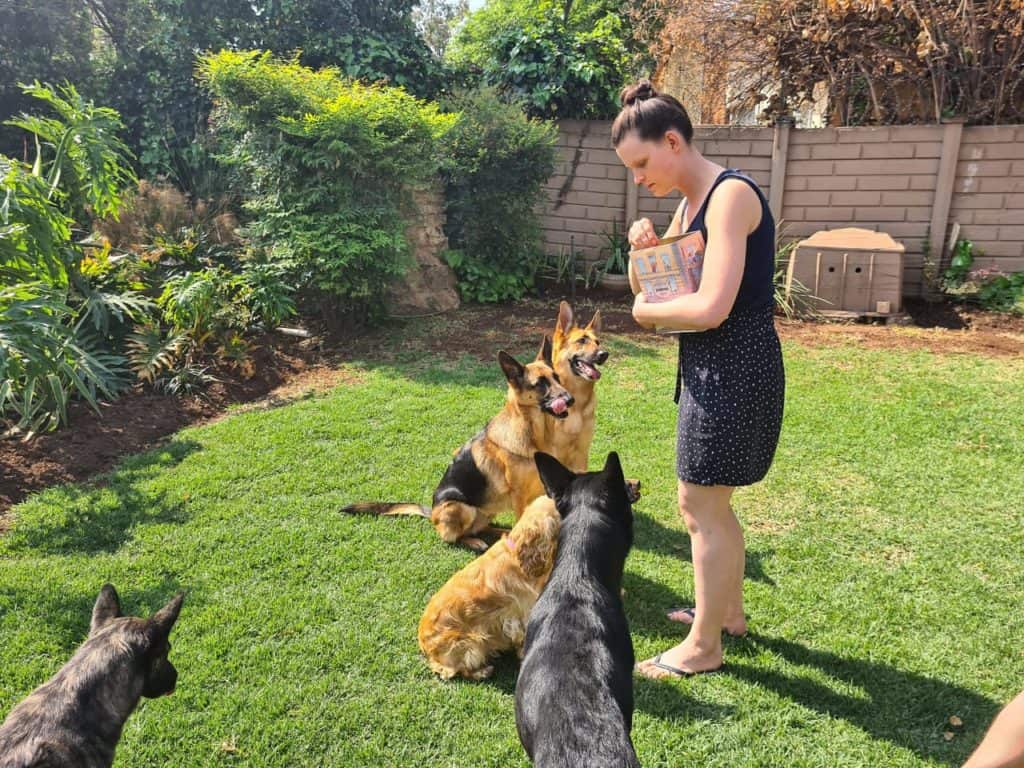
What is Positive Reinforcement in Dog Training?
Positive reinforcement is rewarding your dog for good behavior. No matter how small or insignificant the action may seem, rewarding good behavior helps your dog understand which activities are acceptable and which are not.
You’re conditioning your dog’s mind with positive reinforcement to understand action and consequence. However, instead of negative consequences, we focus on positive ones. These consequences can be using treats, praise, or play as a reward.
We don’t punish our dogs when using the positive reinforcement method. The idea is for your dog to behave acceptably out of choice, not fear! And when you punish a dog, you instill anxiety and diminish your dog’s confidence.
It is a humane way of training your dog while creating a solid dog-owner bond, which will have a lasting impact on every training session in the future.
Why Positive Reinforcement Works
Positive reinforcement works by triggering your dog’s pleasure centers in the brain. Like people, dogs perform better when rewarded than when they’re punished. So, when your dog does something you approve of, reward it. This way, your dog gets something it likes in return for good behavior.
The more your dog is rewarded for good behavior, the more it will strive to repeat said behavior to be rewarded again. Victoria Stillwell explains how you can change your dog’s behavior with positive reinforcement:
- Investigate why your dog acts in a certain way
- Understand your dog’s mannerisms, body language, and reactions
- Learn how to communicate with your dog
- Motivate your dog appropriately through rewards
- Be kind and never punish your dog
- Take training slowly
- Be consistent with your reward system and training methods
- Be patient, not allowing your temper to get in the way of success
Positive Reinforcement; the Paws Perspective Way
The positive reinforcement training method goes by different names. Whether reward-based training, science-based, humane, or anti-cruelty training, they all serve the same purpose: to train your dog with compassion and without force.
Throughout my experience as a dog trainer and writer, I have found sure-fire ways to implement positive reinforcement in your day-to-day life with your dog.
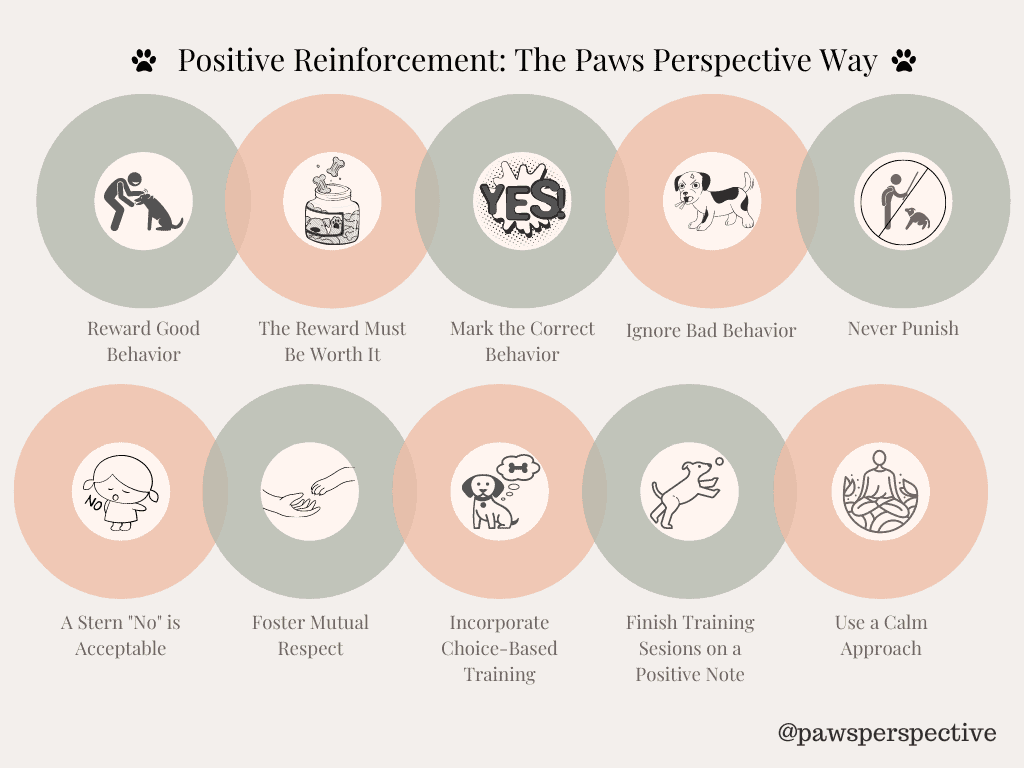
Reward Good Behavior
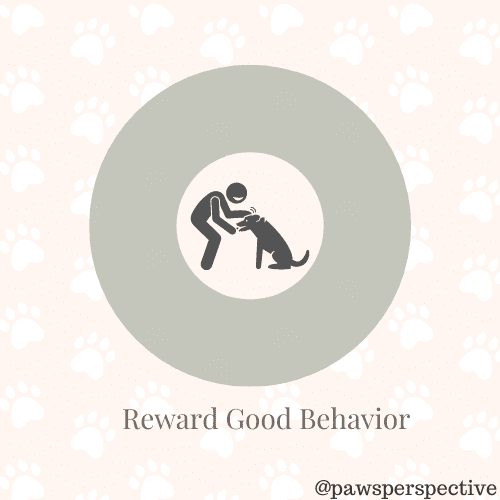
Rewarding good behavior is the key to positive reinforcement. It is the foundation that shapes your dog’s perception of action and consequence in an uplifting way. While the focus is on rewarding the act, there are a few things to keep in mind when rewarding good behavior:
- Timing is essential: Reward your dog immediately after completing the correct action (about three seconds after completing the activity). If you wait too long, your dog might connect the reward with the most recent action it performed. For instance, if your dog sits on command, you wait too long to give a treat, and your dog decides to bark, it might think you’re rewarding the bark instead of the sit.
- Be consistent: Your dog will learn best through consistent repetition, meaning that you should use the same commands, body language, and training methods to teach your dog different behaviors. Inconsistency will only confuse your dog and impede the training process.
- Keep it short: Your dog can’t concentrate for too long. So, short training sessions will help your dog retain more knowledge than extended training periods.
- Wean off the treats: You will reward good behavior every time at the start. But, soon, you’ll need to wean your dog off of needing rewards every time to perform desired behavior successfully. For now, give your dog a reward after every successful action or acceptable behavior it performs.
- Please don’t force your dog: Whenever your dog doesn’t do as you’ve asked, don’t force it into position. Forcing your dog will heighten its anxiety and inhibit its ability to understand what you expect it to do. So, instead of using force, withhold a reward. Usually, your dog will try to figure out why it’s not getting a reward and attempt actions leading to a reward. However, if your dog still struggles with this, abort the mission and move on to the next activity.
The Reward Must Be Worth It
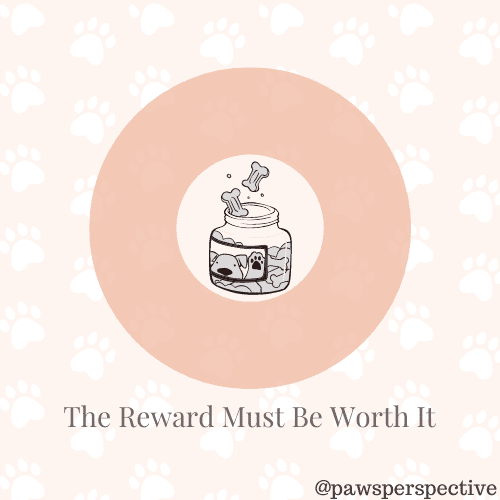
Your dog’s rewards must be of high value to get the most out of each training session. In our post “The Best Way to Train Your Dog- Tips from a Dog Trainer,” we describe the three ways in which dogs can be driven:
- Food-driven
- Toy-driven
- Praise-driven
Once you determine what drives your dog’s actions, you can evaluate which rewards will work best during training sessions. For instance, if your dog is food-driven, you’ll use dog treats, pieces of cheese, or sausage in training sessions. Other dogs might prefer toys or verbal praise, like an excited “good dog” as a reward.
The more value your dog places on the reward, the better the results will be, and the more willing your dog will be to repeat the desired behavior in the future. However, if your dog seems disinterested in the rewards you’re using, consider switching things up.
Mark the Correct Behavior
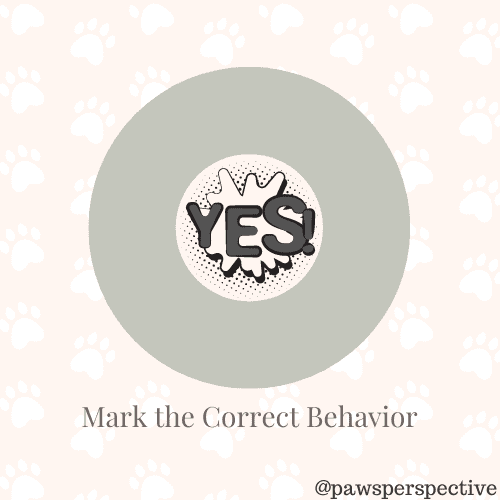
To mark a behavior is to use a marking word, like “yes,” or a clicker to show your dog the exact moment it does what you’ve asked. For instance, if you tell your dog to sit, you will say “yes” or use a clicker when your dog’s bum touches the ground.
Marking the correct behavior will eliminate any guesswork from your dog and identify the right action it should connect to the command you’ve given. See our article on marker training for a step-by-step guide.
Ignore Bad Behavior
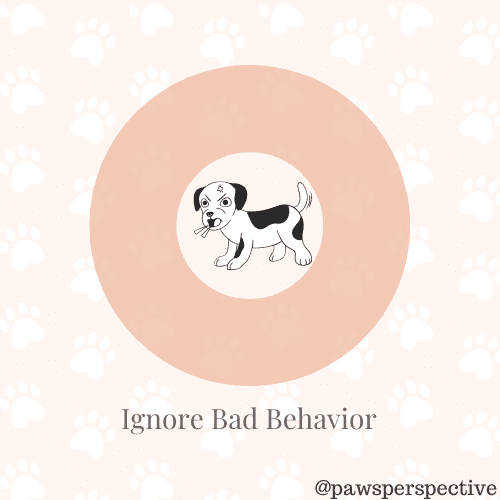
Ignoring lousy behavior has better results than punishing bad behavior. Some people want to physically or verbally punish their dogs for not obeying commands. The truth is that these methods are archaic and inhumane when it comes to modern-day dog training methods.
As you’ve learned, dogs learn better through positive associations and rewards. So, to encourage your dog not to act in undesired ways, you can ignore lousy behavior or withhold rewards.
For instance, if you don’t want your dog to jump up on people, you ignore it whenever it jumps up. Then, when all four paws hit the ground, you’ll give a reward for that action instead.
The idea behind ignoring bad behavior is that your dog strives to impress you. When you ignore your dog, it will try different actions to gain rewards or your praise. Then, through conditioning, your dog will learn which behaviors lead to more rewards and which do not, thus stimulating acceptable behavior.
Never Punish

Punishing a dog for unacceptable behavior might stop the behavior in the short term but won’t be effective long term. It instills fear in your dog, stopping the behavior, but doesn’t teach your dog the acceptable alternative behavior.
For instance, if your dog barks non-stop and you yell at it to stop, it might get frightened and stop barking instantly. However, the success will be short-lived because your dog didn’t learn that being quiet is the desired behavior.
At the same time, punishment might provoke your dog’s suppressed emotional state, such as severe anxiety or aggression. So, to prevent these conditions, never punish your dog. However, a stern “no” is acceptable.
A Stern “No” is Acceptable

While you shouldn’t punish your dog, you can say “no” in a stern tone to teach your dog which actions are unacceptable. However, this will only work in conjunction with rewarding good behavior.
For instance, if you don’t want your dog to take food from the tabletop (assuming your dog can reach the counter), say a stern “no” when it jumps up to get the food. Then, when all four paws are on the ground, give a reward for completing the acceptable action.
The same goes for house training puppies. If your puppy is relieving itself inside your house, never punish them. But if you catch your puppy IN THE ACT, say a stern “no” while taking it to the correct toileting area outside.
So, a stern “no” should always be followed by showing your dog which action is preferred to the behavior it just did.
Foster Mutual Respect
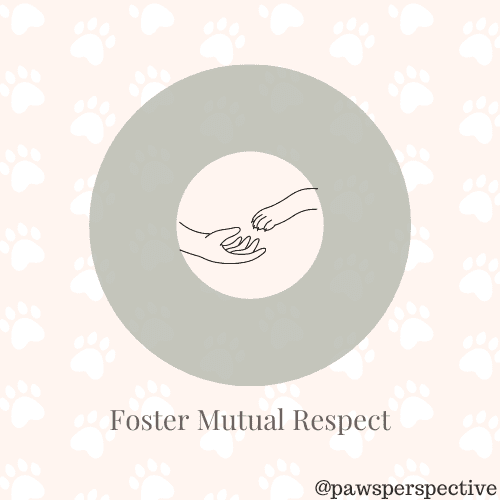
If your dog trusts that you have its best interest at heart, it will be more likely to do as you ask. These interests include your dog’s safety, mental and physical stimulation, and physical needs. Once you meet all these needs, your dog will not feel it has to protect itself or seek stimulation elsewhere.
You gain your dog’s trust with positive reinforcement by creating positive associations with commands and training. The more positive associations your dog makes in its mind, the more it will respect you as the one who calls the shots.
The opposite is also true. The more you punish your dog, the more frightful it will be and the less likely it will successfully do what you’ve commanded. Remember: respect is earned, not given.
Incorporate Choice-Based Training
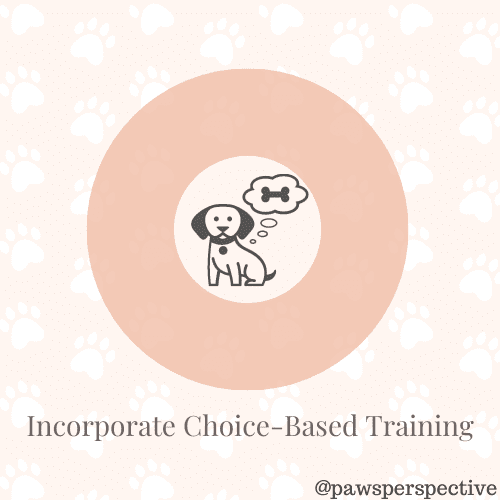
Choice-based training means marking the behaviors you want in your dog and rewarding them. It is conditioning your dog to find motivation through rewards and make the conscious choice to perform those behaviors again in the future.
For instance, if you want your dog to come when you call, you will say “yes” or use a clicker when your dog reaches you from a distance and gives a reward. This way, your dog learns that coming to you has more rewards than staying away from you.
With choice-based training, you never force your dog into a position (like forcing it to sit if it doesn’t want to). You lure your dog into position, giving it a choice to perform an action that will lead to a treat or one that doesn’t. This training method also helps create mutual trust between dog and owner.
Finish Training Sessions on a Positive Note
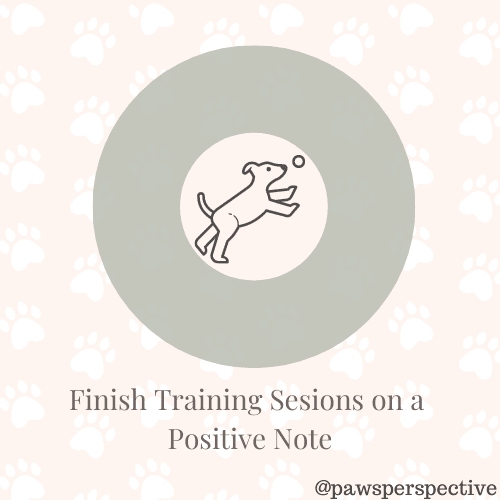
Every training session should end on a positive or successful note. It means that your dog should successfully act before you finish with your session. Not only will it boost your dog’s confidence in training, but it will also encourage a positive association with training sessions in general.
So, end every training session positively by giving your dog a command you know it can perform successfully. Then, if your dog struggles with a down but is reliably successful with a sit, end the training session by asking your dog to sit.
Both you and Then complete the session with a few minutes of playtime. Your dog will feel accomplished when ending on a positive note, making both look forward to the next one. At the same time, if you play a game your dog likes after a training session, the anticipation will help improve the success of the training session.
Use a Calm Approach
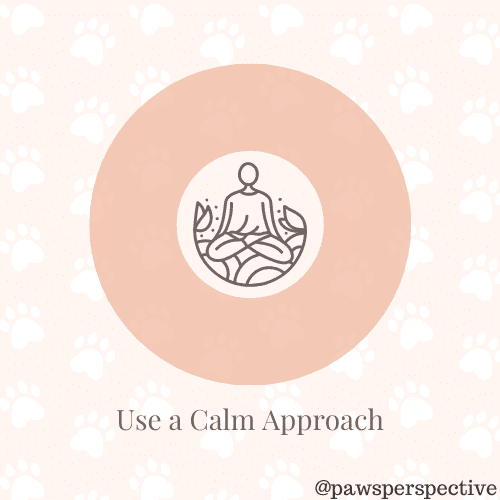
Your dog can sense your emotions. When you are calm, your dog is calm. However, your dog becomes fearful and anxious when angry and frustrated, inhibiting its training ability.
So, keep calm when you train your dog, and NEVER train your dog when you’re upset, have a bad day, or can’t keep your cool. The calmer you are, the easier your dog learns during training sessions.
